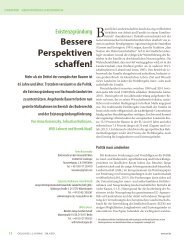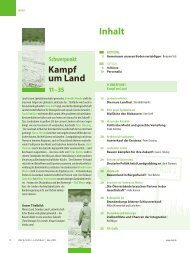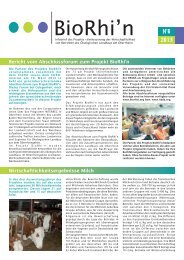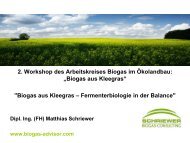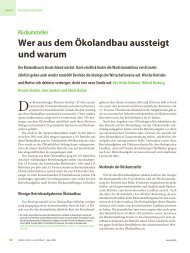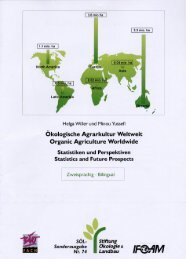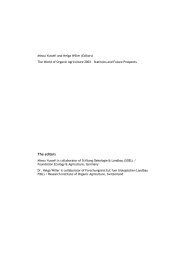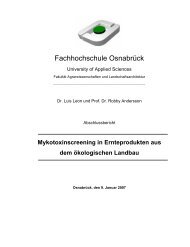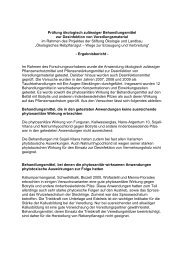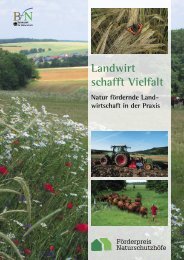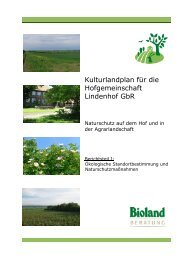the world of organic agriculture - Organic Eprints
the world of organic agriculture - Organic Eprints
the world of organic agriculture - Organic Eprints
Create successful ePaper yourself
Turn your PDF publications into a flip-book with our unique Google optimized e-Paper software.
76<br />
The World <strong>of</strong> <strong>Organic</strong> Agriculture 2006<br />
taking into account <strong>the</strong> technological advances <strong>of</strong> <strong>the</strong> <strong>organic</strong> food industry, <strong>the</strong> development <strong>of</strong><br />
research for <strong>organic</strong> farming/food and <strong>the</strong> growing awareness <strong>of</strong> different consumer groups for<br />
such food. The Codex Commission has now accepted <strong>the</strong>se criteria in 2003. The new criteria for<br />
agricultural inputs as well as those for additives and processing aids are used in such a way that<br />
decisions on future inputs are supported by technical submissions evaluated with <strong>the</strong>se criteria.<br />
In 2005 and 2006 <strong>the</strong> main focus will be restructuring <strong>the</strong> list <strong>of</strong> additives and processing aids<br />
for <strong>organic</strong> food processing taking into account <strong>the</strong> technological functions <strong>of</strong> <strong>the</strong> additives in a<br />
more differentiated way. However it is still not finally decided what <strong>the</strong> nature <strong>of</strong> <strong>the</strong>se lists will<br />
be and which degree <strong>of</strong> detail is desirable as long as <strong>the</strong>se lists are seen as indicative but highconsensus<br />
lists for governments. The complete review <strong>of</strong> <strong>the</strong> full guidelines has been postponed<br />
and will start in 2007 <strong>the</strong> earliest.<br />
Fur<strong>the</strong>r information about Codex Alimentarius is available via <strong>the</strong> homepage www.<br />
codexalimentarius.net. There is also a special homepage on <strong>organic</strong> <strong>agriculture</strong> at <strong>the</strong> FAO<br />
Homepage: www.fao.org/<strong>organic</strong>ag/. The Codex-Alimentarius-Guidelines on <strong>organic</strong> <strong>agriculture</strong><br />
can be downloaded from http://www.codexalimentarius.net/download/standards/360/CXG_<br />
032e.pdf.<br />
9.2 National and Supranational Regulations<br />
9.2.1 The EU Regulation on <strong>Organic</strong> Production<br />
In <strong>the</strong> member states <strong>of</strong> <strong>the</strong> European Union (EU), <strong>the</strong> labeling <strong>of</strong> plant products as <strong>organic</strong><br />
is governed by EU Regulation 2092/91, which came into force in 1993, while products from<br />
<strong>organic</strong>ally managed livestock are governed by EU Regulation1804/99, enacted in August<br />
2000. They protect producers from unfair competition, and <strong>the</strong>y protect consumers from<br />
pseudo-<strong>organic</strong> products. Plant and animal products as well as processed agricultural goods<br />
imported into <strong>the</strong> EU, may only be labeled as <strong>organic</strong> if <strong>the</strong>y conform to <strong>the</strong> provisions <strong>of</strong> EU<br />
Regulation 2092/91. The EU Regulation on <strong>organic</strong> production lays down minimum rules<br />
governing <strong>the</strong> production, processing, storage and import <strong>of</strong> <strong>organic</strong> products and feedstuff for<br />
<strong>organic</strong> husbandry, including inspection procedures, labeling and marketing, for <strong>the</strong> whole <strong>of</strong><br />
<strong>the</strong> European Union. Each European country is responsible for enforcement and for its own<br />
monitoring and inspection system. Applications, supervision and sanctions are dealt with at<br />
regional levels. At <strong>the</strong> same time, each country has <strong>the</strong> responsibility to interpret <strong>the</strong> regulation<br />
on <strong>organic</strong> production and to implement <strong>the</strong> regulation in its national context. Currently <strong>the</strong><br />
regulation is under revision, and <strong>the</strong> European Commission published a proposal for a new<br />
regulation in December 2005 4 .<br />
9.2.1.1 EU logo for <strong>organic</strong> products<br />
In February 2000 <strong>the</strong> European Commission introduced a logo for <strong>organic</strong> products that may<br />
be used throughout <strong>the</strong> EU by producers operating in accordance with <strong>the</strong> provisions <strong>of</strong> <strong>the</strong><br />
EU regulation on <strong>organic</strong> production. The logo may only be used on <strong>organic</strong> products where 95<br />
4 Information on <strong>the</strong> revision <strong>of</strong> EU regulation on <strong>organic</strong> farming is available at http://www.<strong>organic</strong>-europe.net/europe_eu/eu-regulation-2092-91-revision.asp



